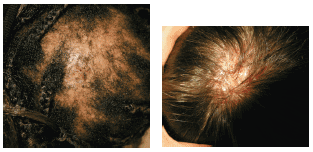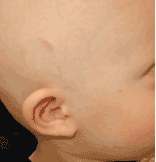Figure 1

Figure 2

3 Phases of Hair Development
- Anagen (growing): 3-7 yr for scalp; 80%-90% of hairs; 50-100 switch to catagen/d (falling out)
- Catagen (resting): 3-4 wk; 1% of hairs
- Telogen (shedding): 3 mo; hairs have short club root; 50-100 hairs shed/day; 10%-15% of hairs in this phase
N.B.: Normal scalp contains 100,000 hairs. Blonds have 120,000 and those with red hair have 80,000 hairs. There are fewer hairs per square cm in Africans & Asians.
Drug Causes of Hair Loss
| Drug Class | Drug |
|---|---|
| Anticoagulants | Coumarins, heparin |
| Antithyroid drugs | Carbimazole, thiouracil |
| Cytotoxic drugs | Adriamycin, colchicines, cyclophosphamide, mercaptopurine derivatives, vinca alkaloids |
Diffuse Hair Loss
- Alopecia areata (diffuse, although most commonly localized)
- Drug-induced: cytotoxics, anticoagulants, retinoids
- Endocrine disorders: hypothyroid, hypopituitarism
- Hair-shaft defects: pili torti, monilethrix
- Male-pattern baldness/androgenetic alopecia
- Nutritional: iron deficiency
- Syphilis
- Systemic lupus erythematosus
- Telogen effluvium
Localized Hair Loss
- Alopecia areata
- Discoid lupus erythematosus
- Fungal infections (e.g., kerion)
- Lichen planopilaris
- Nevoid abnormalities
- Traction (e.g., corn-rows, ponytails)
- Trichotillomania
Nonscarring Alopecia: Intact Hair Follicles
- Telogen effluvium (TE)
- Alopecia areata (AA)
- Anagen effluvium (following chemotherapy)
- Androgenetic alopecia (AGA): male or female pattern baldness
- Trichotillomania
- Infections: fungal (i.e., tinea capitis, kerion)
- Hair shaft abnormalities
Scarring alopecia: Loss of Hair Follicles*
- Discoid lupus erythematosus (DLE)
- Lichen planopilaris (LPP)
- Infections: fungal, bacterial, TB, leprosy
N.B.: If scalp biopsy performed (e.g., scarring alopecia), ideally a 4-mm punch biopsy is taken of a symptomatic or early active disease for transverse sectioning and H&E if lupus suspected, take additional 4-mm punch biopsy—bisect this piece vertically, and submit half for vertical sectioning, and half for DIF.
* In general, scarring alopecias should be referred to a dermatologist.
See Topic(s):